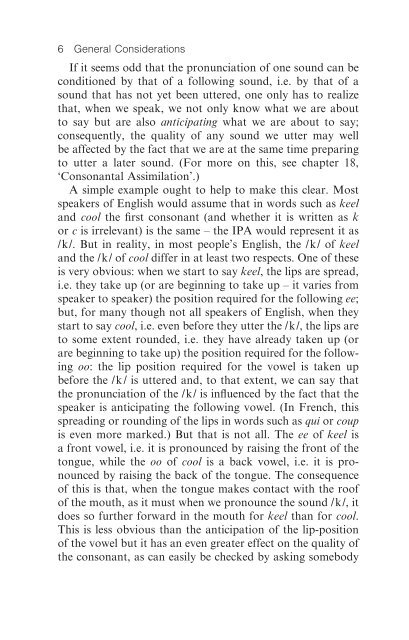An Introduction to French Pronunciation
An Introduction to French Pronunciation
An Introduction to French Pronunciation
Create successful ePaper yourself
Turn your PDF publications into a flip-book with our unique Google optimized e-Paper software.
6 General Considerations<br />
If it seems odd that the pronunciation of one sound can be<br />
conditioned by that of a following sound, i.e. by that of a<br />
sound that has not yet been uttered, one only has <strong>to</strong> realize<br />
that, when we speak, we not only know what we are about<br />
<strong>to</strong> say but are also anticipating what we are about <strong>to</strong> say;<br />
consequently, the quality of any sound we utter may well<br />
be affected by the fact that we are at the same time preparing<br />
<strong>to</strong> utter a later sound. (For more on this, see chapter 18,<br />
‘Consonantal Assimilation’.)<br />
A simple example ought <strong>to</strong> help <strong>to</strong> make this clear. Most<br />
speakers of English would assume that in words such as keel<br />
and cool the first consonant (and whether it is written as k<br />
or c is irrelevant) is the same – the IPA would represent it as<br />
/k/. But in reality, in most people’s English, the /k/ of keel<br />
and the /k/ of cool differ in at least two respects. One of these<br />
is very obvious: when we start <strong>to</strong> say keel, the lips are spread,<br />
i.e. they take up (or are beginning <strong>to</strong> take up – it varies from<br />
speaker <strong>to</strong> speaker) the position required for the following ee;<br />
but, for many though not all speakers of English, when they<br />
start <strong>to</strong> say cool, i.e. even before they utter the /k/, the lips are<br />
<strong>to</strong> some extent rounded, i.e. they have already taken up (or<br />
are beginning <strong>to</strong> take up) the position required for the following<br />
oo: the lip position required for the vowel is taken up<br />
before the /k/ is uttered and, <strong>to</strong> that extent, we can say that<br />
the pronunciation of the /k/ is influenced by the fact that the<br />
speaker is anticipating the following vowel. (In <strong>French</strong>, this<br />
spreading or rounding of the lips in words such as qui or coup<br />
is even more marked.) But that is not all. The ee of keel is<br />
a front vowel, i.e. it is pronounced by raising the front of the<br />
<strong>to</strong>ngue, while the oo of cool is a back vowel, i.e. it is pronounced<br />
by raising the back of the <strong>to</strong>ngue. The consequence<br />
of this is that, when the <strong>to</strong>ngue makes contact with the roof<br />
of the mouth, as it must when we pronounce the sound /k/, it<br />
does so further forward in the mouth for keel than for cool.<br />
This is less obvious than the anticipation of the lip-position<br />
of the vowel but it has an even greater effect on the quality of<br />
the consonant, as can easily be checked by asking somebody












